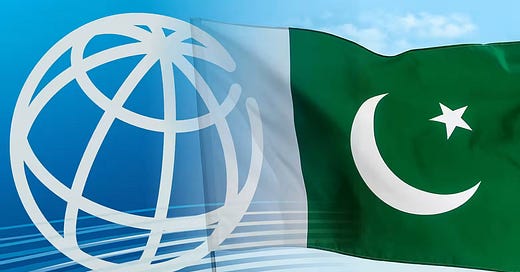Pakistan Secures $40 Billion in World Bank Financing for 10 Years
World Bank Country Director to Pakistan speaks to Nikkei Asia in an exclusive Interview
Dear Readers,
Pakistan is set to receive up to $40 billion in financing from the World Bank over the next decade under a newly introduced Country Partnership Framework (CPF). This landmark initiative marks a shift from previous short-term financial agreements, providing a long-term strategy for sustainable economic growth and development. Of the total amount, $20 billion will be allocated for public-sector projects, while another $20 billion will be directed toward private-sector initiatives through the International Finance Corporation (IFC), an arm of the World Bank.
In an exclusive interview with Nikkei Asia, Najy Benhassine, the World Bank’s Country Director for Pakistan, and Zeeshan Sheikh, IFC’s Country Manager for Pakistan and Afghanistan, provided insight into how this unprecedented financial commitment is structured. They explained that the CPF is designed to address six critical areas: reducing childhood stunting, expanding early education, strengthening climate resilience, improving clean energy and air quality, enhancing public spending on essential services, and boosting private sector investment. One of the most ambitious goals of this program is to reduce Pakistan’s childhood stunting rate, which currently stands at 40%, by nearly a third in the next decade. To achieve this, the World Bank will focus on improving health and nutrition, expanding access to clean water and sanitation, and strengthening family planning initiatives.
Unlike previous World Bank financing agreements, which typically lasted four to six years, this framework spans from 2026 to 2035, ensuring continuity in development efforts even amid political changes. According to World Bank officials, the program is designed to remain resilient against shifts in government, provided that economic policies remain consistent. The IFC, which focuses on the private sector, aims to drive economic growth by moving investments away from speculative ventures such as real estate and encouraging growth in manufacturing, technology, and infrastructure.
In addition to financial support, the World Bank will also provide technical assistance, advisory services, and analytical support to ensure effective implementation. A key element of the program is its collaboration with the International Monetary Fund (IMF) under the Joint Domestic Resource Mobilization Initiative, which aims to achieve a 15% tax-to-GDP ratio. Although the CPF is not directly linked to Pakistan’s IMF bailout program, its success will depend on the country’s ability to maintain economic stability and implement structural reforms.
This program is expected to undergo a mid-term review within five years to assess its progress. If certain areas are not delivering the expected results, adjustments will be made to refocus efforts on more effective strategies. With its long-term approach and emphasis on structural reforms, the CPF represents a significant shift in how the World Bank engages with Pakistan.
For a more detailed breakdown of this initiative, you can read the full article here:
👉 Pakistan Set for $40bn in World Bank Loans Over a Decade.
Best Regards,
Adnan Aamir






